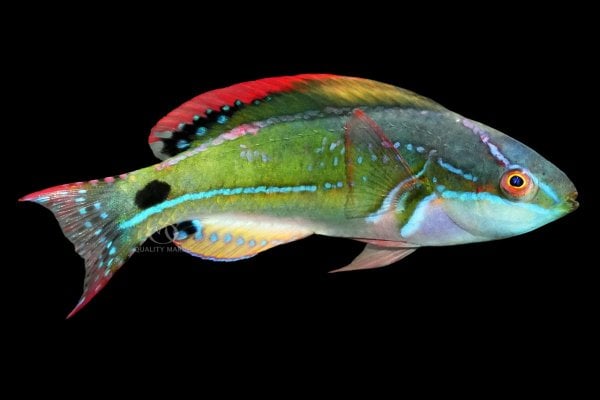We say Cirrhilabrus, and you say beautiful, aquarium appropriate, and peaceful! The best part is you're right on all accounts! Pretty much every fish in this grouping (Cirrhilabrus is a genus) is drop dead gorgeous. Females are pretty, though more subdued than their even flashier, bigger finned male bretheren, which can be nothing short of science fiction pretty, especially when they are showing off for females or defending their harem from other males. One of the most unique species in this group is the fish called the Exquisite Wrasse (Cirrhilabrus exquisitus) and it deserves this name. What makes it interesting is that it might actually be a much larger group of species as these fish have an absolutely huge range, and over this range, can look dramatically different, though they have many traits in common, which is how they got grouped together in the first place.
Like all Cirrhilabrus Wrasses, Exquisites are very active swimmers that are used to eating constantly all day long. While you won't need to offer this demanding feeding regimen to them, you should plan on at least two feedings a day, which is what we do here. More frequent, smaller meals are fine. As plankton feeders, they’re used to eating suspended food and usually adapt well to types of food you'll be offering them in the home aquarium. The biggest challenge is their initial shyness, which might lead to hiding during mealtimes. Their diet should include high-quality pellets, like Nutramar Complete Sinking Pellets. We also mix in various meaty foods from Gamma Foods, including Mysis shrimp, Enhanced Brine Shrimp, Copepods, Finely Chopped Mussel, and Prawn. A good pellet and a broad spectrum of food types will help enhance and maintain their brilliant colors. Click here to learn more

Like all Cirrhilabrus Wrasses, Exquisites are very active swimmers that are used to eating constantly all day long. While you won't need to offer this demanding feeding regimen to them, you should plan on at least two feedings a day, which is what we do here. More frequent, smaller meals are fine. As plankton feeders, they’re used to eating suspended food and usually adapt well to types of food you'll be offering them in the home aquarium. The biggest challenge is their initial shyness, which might lead to hiding during mealtimes. Their diet should include high-quality pellets, like Nutramar Complete Sinking Pellets. We also mix in various meaty foods from Gamma Foods, including Mysis shrimp, Enhanced Brine Shrimp, Copepods, Finely Chopped Mussel, and Prawn. A good pellet and a broad spectrum of food types will help enhance and maintain their brilliant colors. Click here to learn more












